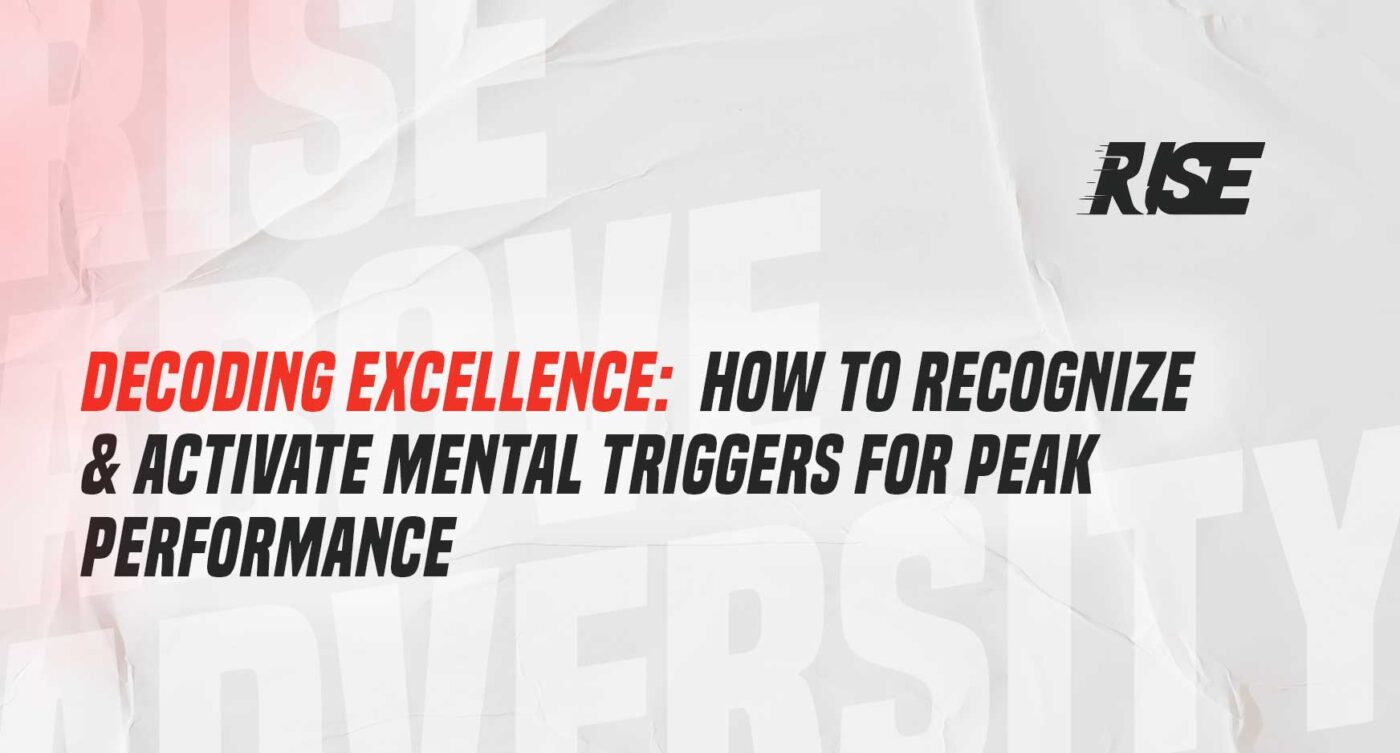As an athlete, it is important to understand what mental triggers help you perform at your peak and what mental triggers hinder you from performing at your best. The more that you can attach a positive outcome to a performance trigger – you get to experience more of the good and less of the bad when it comes to competing.
One of the most frustrating experiences for any athlete is inconsistent performance. Good performances show us what we are capable of while less desirable performances can affect our confidence, belief, and our self-worth. A study into the negative bias of human beings showed that a good day can have no long-lasting effect but a bad day can carry over to the next. This is the same when it comes to competition.
Although many parents and coaches like to see confidence as the issue when it comes to underperforming or inconsistency, (while this can add to it) the real challenge for most athletes is focus.
Focus is the ability to lock into the present moment. For an athlete, it is directing 100% attention to the task at hand. With so much that can happen in competition, it is no wonder most athletes are easily distracted.
The fact is, our body can only ever be in the here and now. Our mind, on the other hand, can venture into the past and future or be aligned with our body in the present moment. While there are many benefits to the ability of our mind to time travel, this can create a split-focus in bouts of competition. To some extent, our mind has to be present to scan for potential threats to keep us safe. A split focus breaks our ability to pay attention to the finer details of the moment by splitting our focus between present-past or present-future. When we position our mind and body in the same place at the same time… we create a synergy between the two that ignites flow states and peak performance.
“Control your thoughts, and you control your emotions. Control your emotions, and you control your actions. Control your actions, and you control the outcome.” – Tim Grover
What is a mental trigger?
A mental trigger is something that affects your emotional state. Our belief system which creates our personalized filter on how we perceive events or process situations – is the basis of the T.F.A.R. Model in Neuro-Linguistic Programming. The T.F.A.R. model is a psychology tool that helps us analyze and understand situations.
In sports, multiple circumstances play out in the course of competition. Whether that be an error or mistake, a great play, a momentum swing, a missed shot, a made shot, a miscue, a good or bad referee call, a coach yelling, an opponent trying to get under your skin, and the list goes on…
Each circumstance creates a thought that is derived from our belief system on a conscious or subconscious level. This means we are either aware of the thought that begins the chain response in T.F.A.R. or we are not. The more consciously aware of our thoughts we are, the better choices of action we can choose to take.
The T.F.A.R. model is a chain reaction that starts with a thought triggered by a circumstance or perspective of a situation. This thought then produces feelings or emotions in the body. Feelings generate actions. And action causes our results.
Thought – the product of mental activity. an idea or opinion produced by thinking, or occurring suddenly in the mind.
So many of our thoughts happen below the surface. Meaning most of the time we don’t even know we are thinking that thought. It happens at a sub-conscious level triggering automatic actions that either help or hinder our performance. The brain takes in so much data through our senses daily that it is impossible to consciously process every single one of them. The brain can process 11,000 bits of data per second through sight, sound, smell, taste, and touch, but the conscious mind can only process 40 to 50 bits of data at any one time.
Feeling – an emotional state or reaction.
A circumstance, situation, or event occurs in performance creating a thought. That thought then produces a feeling in the body. A positive thought can produce a more energized, happy, excited, joyful, or proud feeling in the body. Whereas a thought with a negative connotation might produce a more exhausting, angry, frustrating, overwhelming, or embarrassed feeling within the body. Research shows the emotional feeling in our body lasts for up to 90 seconds. Anything exceeding that time is a personal choice because our feelings are triggered by our thoughts.
“Where focus goes, energy flows. What we feel is a result of what we’re choosing to focus on.” – Tony Robbins
Action – an act; the process of doing something.
Because thoughts create a physiological reaction in the body – it feels so real that we take action from this emotion. In a fear state, the amygdala alerts the body through sweaty palms, an elevated heart rate, jelly legs, and the butterflies in the stomach – causing a fight or flight reaction. Although it is the initial thought that triggers the chain reaction, it is the feeling that drives our action or inaction.
Result – a thing that is caused by something else; a consequence or outcome.
As an athlete, there is so much focus on results. Coaches, scouts, and professional organisations weigh heavily on the outcomes and results. This can be in the wins and losses column or statistics. Results give us the necessary feedback of the actions we take. The beauty of this is with the chain link of T.F.A.R. our results can generally be traced back to an initial thought. Change the thought. Change the result.
For High-Performance athletes, mental triggers are used to create an optimized thought leading to optimized actions through the T.F.A.R. link. Becoming more conscious of the initial thought that leads to great results as well as the thoughts that hinder desired results can help an athlete understand how to get the best out of themselves in the heat of the battle.
“Great athletes train their minds as much as their bodies.” – Mia Hamm
Recognizing Performance Triggers:
1. Goal Clarity:
Having clear performance outcome and process goals allow for increased focus and confidence. Setting clear goals allows them to become aware of veering off-track throughout competition to reset and refocus.
2. Mindfulness Practice:
The consistent practice of mindfulness allows you to become more conscious of the automatic thoughts that lay just below the surface of the conscious mind. These are generally habitual thought processes that trigger the T.F.A.R link without conscious thought. In other words, they are automatic and before you know it you have a result you either like or don’t like.
Mindfulness meditation is the practice of recognizing and catching our thoughts to bring them back to the present moment. This allows us to become more aware of and choose the thoughts that lead to specific outcomes.
3. Daily Journal:
Writing down your thoughts is a powerful tool that can help us become more aware of our thoughts and the results they lead to. The practice of daily journaling allows us to visually see what is going on in our heads. The majority of our thoughts occur at a sub-conscious and unconscious level. Journaling is a powerful problem-solving tool and helps us catch those thoughts and re-frame them to something more helpful.
Journaling pre-performance and post-performance also helps us understand our mental triggers and our performance results better.
4. Watching Film:
Watching yourself in competition can help you see your performance from a third-person perspective. It also can help you recall the thoughts that were happening in the heat of the moment during competition. This will allow you to make adjustments and improvements to similar situations in the future.
5. Thought Record Re-Frame.
Using a CBT (Cognitive Behavioural Therapy) Thought Record can help you capture and identify negative automatic thoughts. Once you have caught some of your negative automatic thoughts, you can practice changing the initial thought to change the feeling. With practice, thinking differently can become second nature.
The best time to complete a thought record is right after you notice a change in how you are feeling. A sudden shift in emotion is a sign that you have had a thought about something. Using a voice memo or writing it down straight away ensures that the incident is still fresh in your mind and allows you to recall and capture the important details. Keeping a record of the circumstance or environment, the thought that occurred, and the emotion you felt can help you become more aware of your mental triggers.
The ultimate goal of any athlete is to deliver their best performance free of distraction regularly. Resilience is a key part of the High-Performance Mindset. Mental resilience at its core, is positively responding to setbacks and having quality distraction control management.
Identifying these triggers and building a management strategy is key to helping an athlete re-focus in those pressure moments or adversity-filled meets. Every individual athlete responds to different pressure points in a manner that is unique to them. Recognizing how those pressure points affect you allows you to build a management strategy that creates resilience and allows you to stay locked into the moment – no matter what is happening around you.
The unpredictability of competition is what makes sport so exciting. The ability to be aware, accept, and let emotion pass to re-focus on the important details of the present moment is what ultimately separates the greatest athletes in the world from the pack. Things won’t always go your way, but the speed at which you can move on gives you the greatest opportunity to maximize your potential more consistently.
“Your thoughts become your actions, your actions become your habits, and your habits become your success.” – Zig Ziglar
– 𝒞ℴ𝒶𝒸𝒽 𝒞𝒶𝓁.

